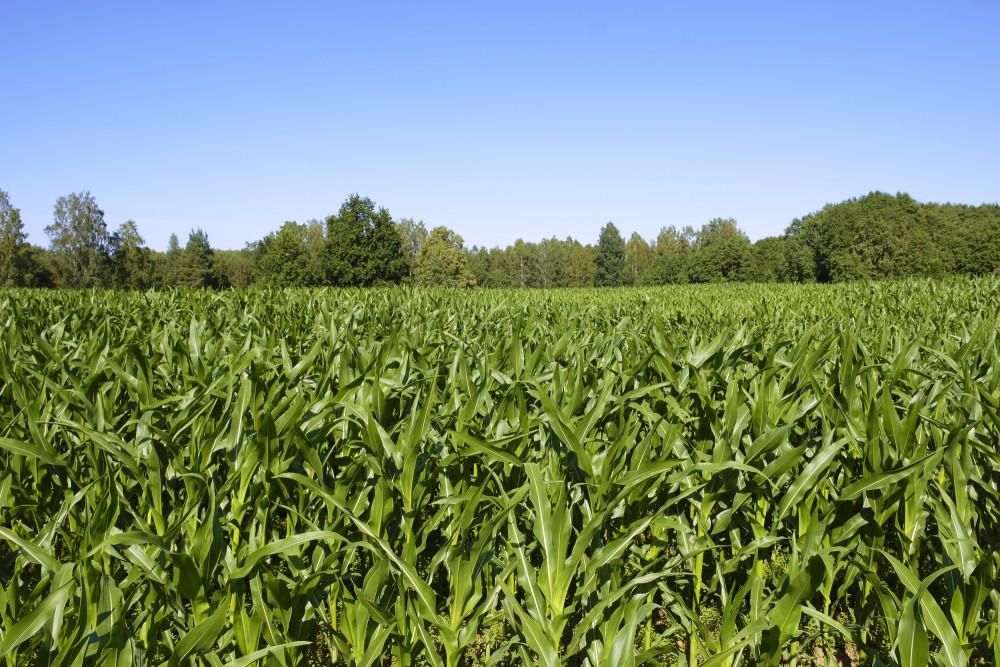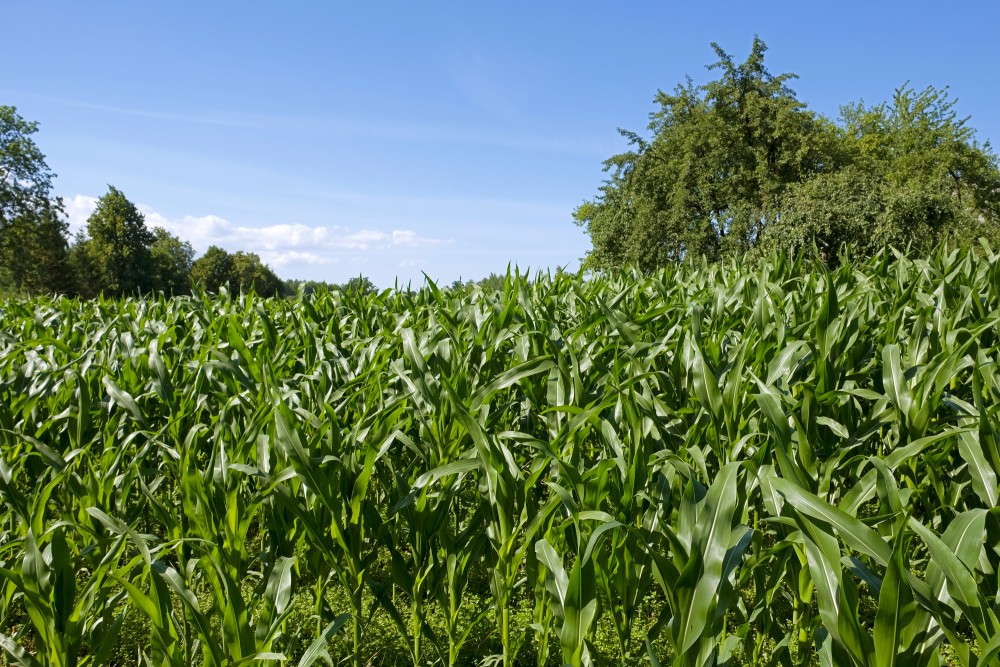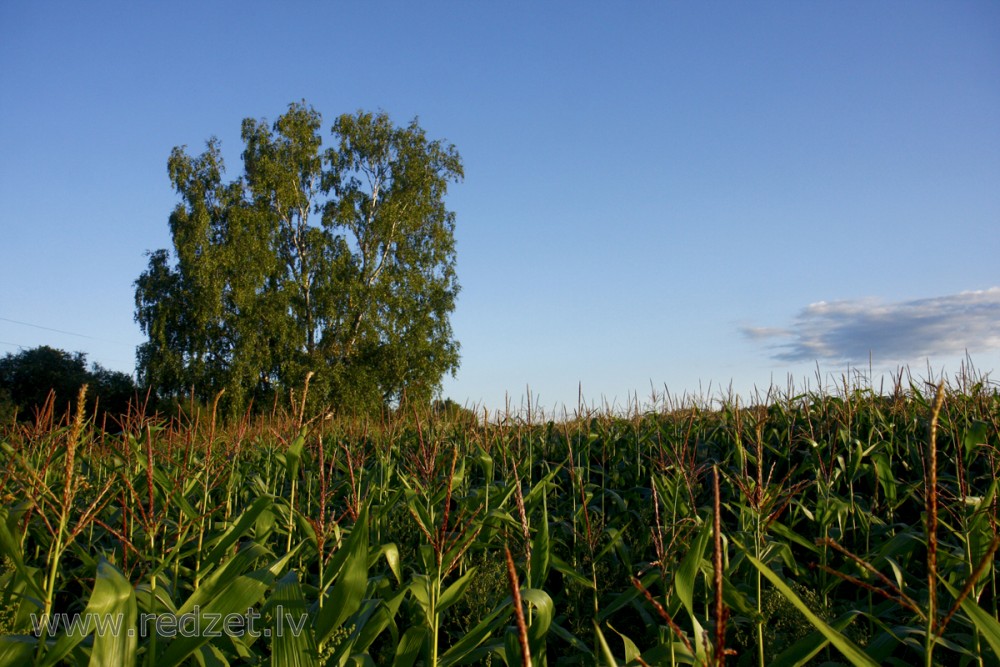Maize (Zea mays)
Maize (/meɪz/ MAYZ; Zea mays), also known as corn (North American and Australian English), is a cereal grain first domesticated by indigenous peoples in southern Mexico about 10,000 years ago. The leafy stalk of the plant produces pollen inflorescences and separate ovuliferous inflorescences called ears that yield kernels or seeds, which are fruits.
Maize has become a staple food in many parts of the world, with the total production of maize surpassing that of wheat or rice. In addition to being consumed directly by humans (often in the form of masa), maize is also used for corn ethanol, animal feed and other maize products, such as corn starch and corn syrup. The six major types of maize are dent corn, flint corn, pod corn, popcorn, flour corn, and sweet corn. Sugar-rich varieties called sweet corn are usually grown for human consumption as kernels, while field corn varieties are used for animal feed, various corn-based human food uses (including grinding into cornmeal or masa, pressing into corn oil, and fermentation and distillation into alcoholic beverages like bourbon whiskey), and as chemical feedstocks. Maize is also used in making ethanol and other biofuels.
Maize is widely cultivated throughout the world, and a greater weight of maize is produced each year than any other grain. In 2014, total world production was 1.04 billion tonnes. Maize is the most widely grown grain crop throughout the Americas, with 361 million metric tons grown in the United States alone in 2014. Genetically modified maize made up 85% of the maize planted in the United States in 2009. Subsidies in the United States help to account for the high level of cultivation of maize in the United States and the fact that the U.S. is the world's largest maize producer.
| Maize | |
| Kingdom: | Plantae |
| Clade: | Tracheophytes |
| Clade: | Angiosperms |
| Clade: | Monocots |
| Clade: | Commelinids |
| Order: | Poales |
| Family: | Poaceae |
| Subfamily: | Panicoideae |
| Genus: | Zea |
| Species: | Z. mays |
History
Pre-Columbian development
Maize is a cultigen; human intervention is required for it to propagate. Whether or not the kernels fall off the cob on their own is a key piece of evidence used in archaeology to distinguish domesticated maize from its naturally-propagating teosinte ancestor. Genetic evidence can also be used to determine when various lineages split.
Most historians believe maize was domesticated in the Tehuacán Valley of Mexico. Recent research in the early 21st century has modified this view somewhat; scholars now indicate the adjacent Balsas River Valley of south-central Mexico as the center of domestication.
An influential 2002 study by Matsuoka et al. has demonstrated that, rather than the multiple independent domestications model, all maize arose from a single domestication in southern Mexico about 9,000 years ago. The study also demonstrated that the oldest surviving maize types are those of the Mexican highlands. Later, maize spread from this region over the Americas along two major paths. This is consistent with a model based on the archaeological record suggesting that maize diversified in the highlands of Mexico before spreading to the lowlands.
Archaeologist Dolores Piperno has said:
A large corpus of data indicates that it [maize] was dispersed into lower Central America by 7600 BP [5600 BC] and had moved into the inter-Andean valleys of Colombia between 7000 and 6000 BP [5000–4000 BC].
— Dolores Piperno, The Origins of Plant Cultivation and Domestication in the New World Tropics: Patterns, Process, and New Developments
Since then, even earlier dates have been published.
According to a genetic study by Embrapa, corn cultivation was introduced in South America from Mexico, in two great waves: the first, more than 6000 years ago, spread through the Andes. Evidence of cultivation in Peru has been found dating to about 6700 years ago. The second wave, about 2000 years ago, through the lowlands of South America.
The earliest maize plants grew only small, 25-millimetre-long (1 in) corn cobs, and only one per plant. In Jackson Spielvogel's view, many centuries of artificial selection (rather than the current view that maize was exploited by interplanting with teosinte) by the indigenous people of the Americas resulted in the development of maize plants capable of growing several cobs per plant, which were usually several centimetres/inches long each. The Olmec and Maya cultivated maize in numerous varieties throughout Mesoamerica; they cooked, ground and processed it through nixtamalization. It was believed that beginning about 2500 BC, the crop spread through much of the Americas. Research of the 21st century has established even earlier dates. The region developed a trade network based on surplus and varieties of maize crops.
Mapuches of south-central Chile cultivated maize along with quinoa and potatoes in pre-Hispanic times; however, potato was the staple food of most Mapuches, "specially in the southern and coastal [Mapuche] territories where maize did not reach maturity". Before the expansion of the Inca Empire maize was traded and transported as far south as 40°19' S in Melinquina, Lácar Department. In that location maize remains were found inside pottery dated to 730 ±80 BP and 920 ±60 BP. Probably this maize was brought across the Andes from Chile. The presence of maize in Guaitecas Archipelago (43°55' S), the southernmost outpost of pre-Hispanic agriculture, is reported by early Spanish explorers. However the Spanish may have misidentified the plant.
Columbian exchange
After the arrival of Europeans in 1492, Spanish settlers consumed maize, and explorers and traders carried it back to Europe and introduced it to other countries. Spanish settlers far preferred wheat bread to maize, cassava, or potatoes. Maize flour could not be substituted for wheat for communion bread, since in Christian belief only wheat could undergo transubstantiation and be transformed into the body of Christ. Some Spaniards worried that by eating indigenous foods, which they did not consider nutritious, they would weaken and risk turning into Indians. "In the view of Europeans, it was the food they ate, even more than the environment in which they lived, that gave Amerindians and Spaniards both their distinctive physical characteristics and their characteristic personalities."Despite these worries, Spaniards did consume maize. Archeological evidence from Florida sites indicate they cultivated it as well.
Maize spread to the rest of the world because of its ability to grow in diverse climates. It was cultivated in Spain just a few decades after Columbus's voyages and then spread to Italy, West Africa and elsewhere.
Structure and physiology
The maize plant is often 3 m (10 ft) in height, though some natural strains can grow 13 m (43 ft). The stem is commonly composed of 20 internodes of 18 cm (7 in) length. The leaves arise from the nodes, alternately on opposite sides on the stalk. A leaf, which grows from each node, is generally 9 cm (3 1⁄2 in) in width and 120 cm (3 ft 11 in) in length.
Ears develop above a few of the leaves in the midsection of the plant, between the stem and leaf sheath, elongating by around 3 mm (1⁄8 in) per day, to a length of 18 cm (7 in) with 60 cm (24 in) being the maximum alleged in the subspecies. They are female inflorescences, tightly enveloped by several layers of ear leaves commonly called husks. Certain varieties of maize have been bred to produce many additional developed ears. These are the source of the "baby corn" used as a vegetable in Asian cuisine.
The apex of the stem ends in the tassel, an inflorescence of male flowers. When the tassel is mature and conditions are suitably warm and dry, anthers on the tassel dehisce and release pollen. Maize pollen is anemophilous (dispersed by wind), and because of its large settling velocity, most pollen falls within a few meters of the tassel.
Elongated stigmas, called silks, emerge from the whorl of husk leaves at the end of the ear. They are often pale yellow and 18 cm (7 in) in length, like tufts of hair in appearance. At the end of each is a carpel, which may develop into a "kernel" if fertilized by a pollen grain. The pericarp of the fruit is fused with the seed coat referred to as "caryopsis", typical of the grasses, and the entire kernel is often referred to as the "seed". The cob is close to a multiple fruit in structure, except that the individual fruits (the kernels) never fuse into a single mass. The grains are about the size of peas, and adhere in regular rows around a white, pithy substance, which forms the ear. The maximum size of kernels is reputedly 2.5 cm (1 in). An ear commonly holds 600 kernels. They are of various colors: blackish, bluish-gray, purple, green, red, white and yellow. When ground into flour, maize yields more flour with much less bran than wheat does. It lacks the protein gluten of wheat and, therefore, makes baked goods with poor rising capability. A genetic variant that accumulates more sugar and less starch in the ear is consumed as a vegetable and is called sweet corn. Young ears can be consumed raw, with the cob and silk, but as the plant matures (usually during the summer months), the cob becomes tougher and the silk dries to inedibility. By the end of the growing season, the kernels dry out and become difficult to chew without cooking them tender first in boiling water.
Planting density affects multiple aspects of maize. Modern farming techniques in developed countries usually rely on dense planting, which produces one ear per stalk. Stands of silage maize are yet denser, and achieve a lower percentage of ears and more plant matter.
Maize is a facultative short-day plant and flowers in a certain number of growing degree days > 10 °C (50 °F) in the environment to which it is adapted. The magnitude of the influence that long nights have on the number of days that must pass before maize flowers is genetically prescribed and regulated by the phytochrome system. Photoperiodicity can be eccentric in tropical cultivars such that the long days characteristic of higher latitudes allow the plants to grow so tall that they do not have enough time to produce seed before being killed by frost. These attributes, however, may prove useful in using tropical maize for biofuels.
Immature maize shoots accumulate a powerful antibiotic substance, 2,4-dihydroxy-7-methoxy-1,4-benzoxazin-3-one (DIMBOA). DIMBOA is a member of a group of hydroxamic acids (also known as benzoxazinoids) that serve as a natural defense against a wide range of pests, including insects, pathogenic fungi and bacteria. DIMBOA is also found in related grasses, particularly wheat. A maize mutant (bx) lacking DIMBOA is highly susceptible to attack by aphids and fungi. DIMBOA is also responsible for the relative resistance of immature maize to the European corn borer (family Crambidae). As maize matures, DIMBOA levels and resistance to the corn borer decline.
Because of its shallow roots, maize is susceptible to droughts, intolerant of nutrient-deficient soils, and prone to be uprooted by severe winds.
While yellow maizes derive their color from lutein and zeaxanthin, in red-colored maizes, the kernel coloration is due to anthocyanins and phlobaphenes. These latter substances are synthesized in the flavonoids synthetic pathway from polymerization of flavan-4-ols by the expression of maize pericarp color1 (p1) gene which encodes an R2R3 myb-like transcriptional activator of the A1 gene encoding for the dihydroflavonol 4-reductase (reducing dihydroflavonols into flavan-4-ols) while another gene (Suppressor of Pericarp Pigmentation 1 or SPP1) acts as a suppressor. The p1 gene encodes an Myb-homologous transcriptional activator of genes required for biosynthesis of red phlobaphene pigments, while the P1-wr allele specifies colorless kernel pericarp and red cobs, and unstable factor for orange1 (Ufo1) modifies P1-wr expression to confer pigmentation in kernel pericarp, as well as vegetative tissues, which normally do not accumulate significant amounts of phlobaphene pigments. The maize P gene encodes a Myb homolog that recognizes the sequence CCT/AACC, in sharp contrast with the C/TAACGG bound by vertebrate Myb proteins.
Abnormal flowers
Maize flowers may sometimes exhibit mutations that lead to the formation of female flowers in the tassel. These mutations, ts4 and Ts6, prohibit the development of the stamen while simultaneously promoting pistil development. This may cause inflorescences containing both male and female flowers, or hermaphrodite flowers.
en.wikipedia.org









